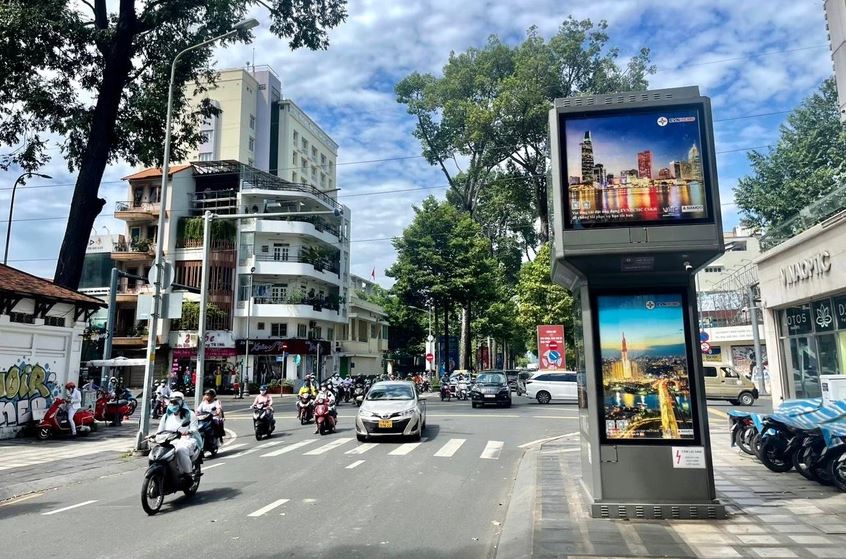
Undergrounding power grid contributes to urban renewal and improves city aesthetics. Photo: Ho Chi Minh City Law
Reporter: Sir, over the past 20 years, how has the power sector aggressively implemented the undergrounding of the power grid combined with telecommunication cables?
Mr. Bui Hai Thanh: In the early 2000s, Ho Chi Minh City faced a situation where overhead power and telecommunication cables were tangled, often referred to by residents as "spider webs" on the streets. In response to this issue, the Ho Chi Minh City People's Committee identified undergrounding the power grid combined with telecommunication cables as a priority to build a modern, civilized urban area.
From 2003 to 2005, the Ho Chi Minh City Power Company (the predecessor of the Ho Chi Minh City Power Corporation) piloted undergrounding the power grid on streets such as Le Loi, Le Duan, Nguyen Hue, Nam Ky Khoi Nghia - Nguyen Van Troi, with a total of 9.2km of medium-voltage lines and 9.5km of low-voltage lines completed.
However, this undergrounding was not comprehensive as it only involved the power grid and did not include telecommunication and lighting cables, leaving the "spider web" of telecommunication cables unresolved.
By 2009-2010, the power sector implemented five pilot projects to underground both the power grid and telecommunication cables in areas around the City Party Committee Hall, Ben Thanh Market, and streets like Tran Hung Dao, Le Thanh Ton, and Truong Dinh. The completed work included 9.23km of medium-voltage lines and 46.57km of low-voltage lines.
Notably, in 2014, the Ho Chi Minh City People's Committee established the "Steering Committee for Undergrounding the Power Grid Combined with Telecommunication Cables in Ho Chi Minh City" to increase the volume and accelerate the pace of undergrounding.
During the 2016-2020 period, EVNHCMC developed a more detailed plan, expanding the scope to other inner-city districts such as District 7, District 5, District 10, and parts of suburban areas, applying modern technologies to minimize construction impacts.
The 2021–2025 period is when Ho Chi Minh City focuses on completing the underground power grid system while laying the foundation for smart urban development goals.
Reporter: Could you share more specifically about the practical benefits that the undergrounding of the power grid has brought to Ho Chi Minh City?
Mr. Bui Hai Thanh:
The undergrounding of the power grid has brought many practical benefits to Ho Chi Minh City, such as: Major streets have become clearer, free from tangled wires, creating a positive impression for visitors and enhancing the city’s image;
The risk of electrical short circuits, fires, or weather-related incidents has been significantly reduced, ensuring safety for residents; the underground cable system minimizes power outages, better meeting the city’s growing electricity consumption needs; underground infrastructure facilitates the deployment of technological applications such as smart transportation, energy management, and digital connectivity.
Currently, the reliability index of electricity supply in Ho Chi Minh City is on par with advanced cities in the region and worldwide.

Construction of underground power grid on Nguyen Thoi Trung Street, District 5 (Ho Chi Minh City)
Reporter: Thanh An is the first island commune to have its power grid undergrounded. How was the undergrounding of the power grid carried out in this island commune, sir?
Mr. Bui Hai Thanh: Previously, the residents of Thanh An island commune mainly relied on small-scale power sources such as diesel generators and low-capacity solar energy systems. This led to intermittent power supply and unstable electricity quality, significantly affecting the daily lives and production activities of the local people.
Recognizing these challenges, EVNHCMC resolved to invest in constructing a 24kV medium-voltage cable line stretching over 6,000 meters across the sea to bring the national power grid to the island commune.
Building on these achievements, in 2022, EVNHCMC continued to invest in undergrounding the power grid on the island. This marked a significant milestone, making Thanh An the first locality to have its entire power grid undergrounded. The primary goal was to ensure a sustainable and safe power supply, particularly by minimizing disruptions caused by harsh weather conditions during the rainy and stormy season.
Reporter: Moving forward, how will EVNHCMC expand the underground power grid system in central areas and new urban zones, sir?
Mr. Bui Hai Thanh: Looking to the future, Ho Chi Minh City aims to continue expanding the underground power grid system, targeting 100% undergrounding of the power grid in the central area and new urban zones by 2030. At the same time, the city will integrate underground infrastructure with sustainable development projects, such as renewable energy and smart management systems, to affirm its position as a leading urban center in the region.
Reporter: Thank you, sir!
Translator: Vân Ly
Share